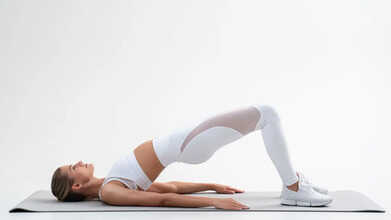- Health Conditions A-Z
- Health & Wellness
- Nutrition
- Fitness
- Health News
- Ayurveda
- Videos
- Medicine A-Z
- Parenting
- Web Stories
Six Pilates Moves That Will Reduce Joint Pain While Walking

Credits: Canva
Walking is the most convenient exercise around—it's low-impact, no cost, and has immense benefits to our health, ranging from the improvement of cardiovascular health to aiding weight control and stress relief. Yet, for many of us, walking can also be a pain. If you feel joint discomfort, muscle soreness, or overall stiffness after or even during a walk, then it's time to look beneath the surface.
Wincing when walking usually corresponds with the absence of mobility or strength in the important areas such as hips, knees, ankles, and core. That is where Pilates, a low-impact, holistic conditioning technique, comes into play. Pilates not only enhances strength, mobility, and balance but also teaches the body to move effectively, saving it from injury and pain.
Pilates is an excellent exercise for strengthening the legs and increasing joint mobility, particularly for people with lower body pain. Pilates also enhances deep core activation, which stabilizes posture and walking mechanics.
If you're inactive, rehabbing from an injury, or just want to make walking easier, these six Pilates exercises for beginners can help you develop strength and flexibility, starting from the ground up.
1. Deep Squat
The deep squat is a basic movement that engages the hips, knees, and ankles—three big joints of walking.
How to Do It:
Stand feet wider than hip-width apart. Slowly descend into a squat, keeping heels on the ground if possible (it's okay if they do lift). Use a support such as a chair or banister for stability. Rock side to side gently while in the position.
Why It Helps:
This move improves hip mobility and ankle flexibility, two areas that directly affect stride length and shock absorption during walking. Poor hip function often causes compensatory pain in the knees or lower back.
2. Calf Raises
Ankle instability or weak calves can reduce the push-off strength in each step, making walking less efficient and more painful.
How to Do It:
Stand facing a wall, placing your fingertips on it for balance. Rise up onto your toes, pause for a second, and then lower slowly. Once you’re comfortable, try doing the movement one leg at a time.
Why It Helps:
This strengthens the calves and ankle stabilizers, enhancing your gait and supporting the knee joint above. Strong calves also reduce strain on the plantar fascia, which can prevent foot pain.
3. Leg Swings
This exercise is commonly applied as a dynamic warm-up. It addresses tight hip flexors and is beneficial for fluid movement.
How to Do It:
Stand to one side of a wall, holding onto it for balance. Swing the outside leg back and forth in a loose motion. Allow your pelvis to rotate naturally with the swing.
Why It Helps:
Releasing tension in the hips facilitates better range of motion when walking. Tight hip flexors are a frequent source of back and knee pain.
4. Hip Stretch
Following a walk, stretching your hip flexors and quads can avoid stiffness and pain from developing.
How to Do It:
Kneel on your left leg with the right foot in front. Tuck your pelvis forward slightly and lean forward slowly. Hold the stretch, and then reverse sides.
Why It Helps:
This exercise reverses the repetitive action of walking by stretching out the hip flexors and reducing strain on the lower back.
5. Seated Glute Stretch
Sitting can lead to tightening of the glutes, affecting walking mechanics.
How to Do It:
Sit in a chair, cross your right ankle over your left knee. Hinge forward at the hips, keeping your back straight, until you feel a stretch in the right glute. Repeat on the opposite side.
Why It Helps:
Tight glutes and piriformis muscles can cause sciatica-like symptoms. Stretching them prevents nerve compression and encourages pelvic alignment.
6. Thread the Needle
Don't forget the spine—particularly the thoracic (upper back) section, which is responsible for arm swing and stability when walking.
How to Do It:
Start on all fours. Pass your right arm across under your left arm, turning until your shoulder is on the mat. Release and reach that arm up toward the ceiling. Repeat on the other side.
Why It Helps:
It relaxes the shoulders and mid-back, reversing tightness from bad posture and supporting whole-body coordination.
Why Making Joint-Friendly Movement Is Important?
Joint pain, no matter its cause, can significantly change your way of moving—and even prevent you from moving altogether. Pilates provides a gentle, systematic means of restoring mobility without causing more stress.
As we get older, it becomes essential to learn to control breathing and stabilize our core while we move. Pilates addresses both. Pilates makes us move with awareness, which decreases pain and increases confidence. Still debating if doing six exercises is worth being able to walk better?
A 2023 paper published in GeroScience emphasizes walking as a highly potent anti-aging intervention. Studies have shown that walking daily lessens the risk of chronic disease, enhances mental health, and even improves sleep quality. Walking without pain is walking farther—and reaping all the rewards that go along with it.
Tips To Ease Joint Pain
If joint pain lasts more than general stiffness, talk to a physical therapist or rheumatologist. Long-term pain is associated with underlying conditions such as rheumatoid arthritis or osteoarthritis. Meanwhile, minor lifestyle changes can assist:
- Moist heat or cold packs for places such as the jaw and neck
- Wrist and elbow splints or pillows for support
- Finger and hand exercises to preserve dexterity
- Hip bridges or knee stretches for persistent lower-body tightness
Pregnant And Doing Yoga? These Are The Yoga Poses To Skip For Safety

Credits: Canva
Yoga is one of the safest and most effective exercises you can do while pregnant, it can help you relax, stay strong, and even get ready for childbirth, according to the Mayo Clinic. However, it is important to take precautions to protect both yourself and your growing baby. While many yoga poses are beneficial during pregnancy, there are some you should avoid. Below, we highlight the yoga poses to steer clear of while expecting.
Is It Safe To Practice Yoga In Pregnancy?
Pregnancy brings a lot of physical changes and discomfort, but that does not mean you have to give up yoga entirely if you already practice it. Many poses are still safe to continue, while others may need to be modified or avoided completely.
Benefits Of Yoga During Pregnancy
Prenatal yoga provides many physical and mental benefits. It improves strength and flexibility, reduces stress and anxiety, eases common pregnancy discomforts like back pain and fatigue, enhances sleep, and prepares both body and mind for labor. Yoga can also help regulate blood pressure, improve circulation, and foster a stronger connection between mother and baby.
Yoga Poses To Avoid During Pregnancy
Here’s a guide to the yoga poses that are best avoided during pregnancy:
Abdominal Work
Any pose that puts pressure on your abdomen can create unnecessary compression and affect blood flow. These poses may also increase strain on your body and contribute to conditions like diastasis recti, where the abdominal muscles separate during pregnancy.
Some poses to avoid include:
- Crow Pose
- Bicycles
- Planks
- Crunches
Twisting & Stretching
Twists are not entirely off-limits during pregnancy. With your doctor’s approval, open twists in the third trimester can feel good and may even help relieve tension. Twisting should come from the shoulders rather than the abdomen, keeping the belly open and never compressed.
Some poses to avoid include:
- Moon Pose
- Spinal Twist
- Boat Pose
- Tree Pose
Jumping or Fast Flowing
Rapid movements or lots of jumping in early pregnancy may cause nausea. Yoga poses that involve quick, high-impact motions should be avoided. Gentle, restorative postures are a safer choice, supporting fetal growth and reducing potential complications.
Poses to avoid:
- Any yoga movement involving rapid or forceful motion
Lying Back
Lying flat on your back during pregnancy can cause nausea, back pain, increased blood pressure, and heartburn. Long periods in this position may also compress the vena cava, the vein that carries blood from the lower body to the heart, which can lead to complications.
Poses to avoid:
- Corpse Pose
- Lying Down Body Twist
- Boat Pose
- Plough Pose
Heated Yoga
Some yoga practices raise your body temperature. During pregnancy, it’s crucial to avoid poses that overheat the body, as this can lead to dehydration and other complications throughout all trimesters.
Poses to avoid:
- Kapalbhati (Breath of Fire Pose)
- Headstand
- Warrior Pose
- Bikram Pose
Belly Down
Poses that put extra pressure on your abdomen can be risky while your baby is growing. Any yoga that requires lying on or bending the stomach should be avoided.
Poses to avoid:
- Swan Pose
- Cobra Pose
- Seated Forward Bend
- Bow Pose
Tyreek Hill Injury: Left Knee Dislocated; Know More About The Common Leg Injuries In Football

Credits: AP
Miami Dolphin's Tyreek Hill's season came to a sudden end on Monday night, when his knee became badly twisted shortly after he made a catch near the sideline. The coach Mike McDaniel confirmed that Hill was diagnosed with a dislocated knee and had to be in hospital overnight.
An air cast was also placed over his leg, which was taken off the field on cart. He was then taken to a nearby hospital, and kept for "imaging, evaluation, and observation".
McDaniel said, "He immediately had wide eyes and was talking, 'I'm good, just make sure the guys get this win.' He was focused on the team."
As of now, Hill will be undergoing an MRI exam and a CT scan. His agent Drew Rosenhaus told WSVN that he is being checked for any torn ligaments, cartilage, broken bones or nerve damage.
Associated Press has reported that Hill ha been taken off field for left knee dislocation.
What Happens In A Knee Dislocation?
As per the National Institute of Health, US, a knee dislocation is a potentially devastating injury and is often a surgical emergency. Knee dislocations comprise ligamentous, bony, and neurovascular injuries that, when unrecognized, significantly increase the risk of amputation of the affected limb. Even dislocations that spontaneously reduce before evaluation by a healthcare professional carry the risk of significant neurovascular injury.
Delayed diagnosis and management of knee dislocations increases the risk of long-term arthrofibrosis and joint instability. While most dislocated knees never fully return to their pre-injury state, timely and accurate diagnosis paired with prompt intervention can significantly improve outcomes for patients with this potentially complex orthopedic injury.
Common Leg Injuries In Football
As per the Southern Pain and Neurological Clinic, football is one of the most dangerous contact sports in the United States, this is also a reason why players wear layers of protective clothing and equipment.
According to the National Library of Medicine, the most common injury types in football include strains at 40%, contusions at 25%, dislocations at 15%, fractures at 10%, and concussions at 5%.
Read: 21-year-old Billy Vigar Of Chichester City Dies Of Sustaining Brain Injury
Common Injuries Include:
Muscle Strains
This happens when a muscle or tendon is overstretched, mainly due to acceleration or deceleration. This injury is also known as pulled muscles and typically affects the lower back, hamstrings, or ankles.
Knee Ligament Injury
Ligaments connect bones in the body, and ligaments that connect the lower leg to the thigh bone are most susceptible to injuries in football.
There are four knee ligaments injuries that can happen:
- ACL or the Anterior cruciate ligament at the center of the knee
- PCL or the Posterior cruciate ligament at the center of the knee
- MCL or the Medial collateral ligament on the inside of the knee
- LCL or the Lateral collateral ligament on the outside of the knee
Among these, the most common knee ligament injury in football is the rapture of the ACL. This is because it is the ligament that controls the rotation of the shinbone and forward movement.
Achilles Tendonitis
This happens when the tendon linking the calf muscles to the heel becomes irritated or injured. This often results from intense or repetitive strain. The condition can cause sharp pain and, in severe cases, make it difficult or even impossible to walk, jump, or move the toes.
Hamstring Strains
This happens when a player over stretches while running, jumping, or in action. This happens with a sharp pain at the back of the thigh and in severe cases, a player may have a torn hamstring.
5 Pelvic Floor Exercises That Can Transform Your Sexual Wellness

Credits: Canva
Your pelvic floor muscles do much more for your sexual health than most people realise. These deep muscles support the bladder, uterus, and bowel, but they also play a big part in pleasure, performance, and confidence during intimacy.
Whether you’re healing after childbirth, managing incontinence, or simply aiming to feel more connected with your body, training your pelvic floor is a natural way to improve sexual wellness.
What Is Pelvic Floor Exercise?
Pelvic floor exercises, often called Kegels, focus on strengthening the group of muscles that create a supportive sling for the bladder, bowel, and, in women, the uterus. They are done by contracting these muscles, as if stopping the passage of urine or gas, holding the squeeze, and then releasing. Regular practice can improve bladder and bowel control, enhance sexual health, and aid recovery following childbirth in women or prostate surgery in men.ALSO READ: Is It Safe To Have Sex With Heart Disease? Expert Tells 5 Things You Should Keep In Mind
Benefits of Pelvic Floor Exercise For Better Sexual Health
Pelvic floor exercises can make a real difference in your sexual life. As per Mayo Clinic, by strengthening the muscles that support the bladder, uterus, and bowel, these exercises improve blood flow and muscle control in the pelvic area. This not only enhances arousal and sensitivity but can also lead to stronger orgasms and better stamina during intimacy. For many people, a stronger pelvic floor helps reduce discomfort, boost confidence, and create a greater sense of connection with their body and partner.ALSO READ: Can A UTI Cause You Your Limbs? Explains Doctor
5 Pelvic Floor Exercises to Boost Sexual Health
1. Kegel Exercises
How to do it:- Squeeze the muscles you use to stop urinating.
- Hold for 5 seconds, then relax for 5 seconds.
- Repeat 10–15 times, two to three times daily.
2. Bridge Pose
How to do it:- Lie on your back with your knees bent and feet flat.
- Lift your hips upward while tightening your glutes and pelvic muscles.
- Hold briefly, then lower down.
3. Deep SquatsHow to do it:
- Stand with your feet hip-width apart.
- Lower into a deep squat, keeping your chest lifted.
- Engage your pelvic muscles as you come back up.
4. Bird-Dog
How to do it:- Begin on your hands and knees.
- Extend your right arm and left leg at the same time.
- Hold, then switch sides.
5. Pelvic Tilts
How to do it:- Lie on your back with your knees bent.
- Flatten your lower back into the floor by tilting your pelvis upward.
- Hold for a few seconds, then relax.
© 2024 Bennett, Coleman & Company Limited

